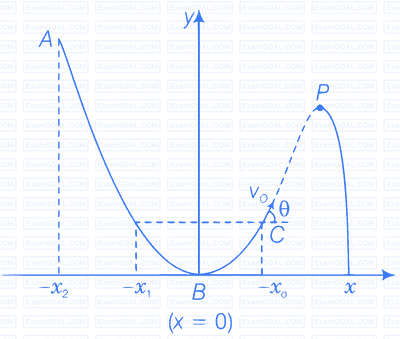Two particles are projected in air with speed $v_0$ at angles $\theta_1$ and $\theta_2$ (both acute) to the horizontal, respectively. If the height reached by the first particle is greater than that of the second, then tick the right choices.
Angle of projection $q_1 > q_2$
Time of flight $T_1 > T_2$
Horizontal range $R_1 > R_2$
Total energy $U_1 > U_2$
A particle slides down a frictionless parabolic $(y + x^2)$ track $A – B – C$ starting from rest at point A (figure). Point B is at the vertex of parabola and point C is at a height less than that of point A. After C, the particle moves freely in air as a projectile. If the particle reaches highest point at P, then

KE at P = KE at B
height at P = height at A
total energy at P = total energy at A
time of travel from A to B = time of travel from B to P
Following are four different relations about displacement, velocity and acceleration for the motion of a particle in general. Choose the incorrect one(s).
$v_{av} = \frac{1}{2}\left[ v(t_1) + v(t_2) \right]$
$v_{av} = \frac{r(t_2) - r(t_1)}{t_2 - t_1}$
$r = \frac{1}{2} \left( v(t_2) - v(t_1) \right) (t_2 - t_1)$
$a_{av} = \frac{v(t_2) - v(t_1)}{t_2 - t_1}$
For a particle performing uniform circular motion, choose the correct statement(s) from the following.
Magnitude of particle velocity (speed) remains constant
Particle velocity remains directed perpendicular to radius vector
Direction of acceleration keeps changing as particle moves
Angular momentum is constant in magnitude but direction keeps changing
For two vectors A and B, |A + B| = |A − B| is always true when
|A| = |B| ≠ 0
A ⊥ B
|A| = |B| ≠ 0 and A and B are parallel or anti-parallel
when either |A| or |B| is zero